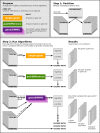A comparative study of survival models for breast cancer prognostication revisited: the benefits of multi-gene models
- PMID: 30390622
- PMCID: PMC6215649
- DOI: 10.1186/s12859-018-2430-9
A comparative study of survival models for breast cancer prognostication revisited: the benefits of multi-gene models
Abstract
Background: The development of clinical -omic biomarkers for predicting patient prognosis has mostly focused on multi-gene models. However, several studies have described significant weaknesses of multi-gene biomarkers. Indeed, some high-profile reports have even indicated that multi-gene biomarkers fail to consistently outperform simple single-gene ones. Given the continual improvements in -omics technologies and the availability of larger, better-powered datasets, we revisited this "single-gene hypothesis" using new techniques and datasets.
Results: By deeply sampling the population of available gene sets, we compare the intrinsic properties of single-gene biomarkers to multi-gene biomarkers in twelve different partitions of a large breast cancer meta-dataset. We show that simple multi-gene models consistently outperformed single-gene biomarkers in all twelve partitions. We found 270 multi-gene biomarkers (one per ~11,111 sampled) that always made better predictions than the best single-gene model.
Conclusions: The single-gene hypothesis for breast cancer does not appear to retain its validity in the face of improved statistical models, lower-noise genomic technology and better-powered patient cohorts. These results highlight that it is critical to revisit older hypotheses in the light of newer techniques and datasets.
Keywords: Multi-gene models; Single-gene models; Survival models.
Conflict of interest statement
Ethics approval and consent to participate
Not applicable.
Consent for publication
Not applicable.
Competing interests
The authors declare that they have no competing interests.
Publisher’s Note
Springer Nature remains neutral with regard to jurisdictional claims in published maps and institutional affiliations.
Figures



References
-
- van’t Veer LJ, Dai H, van de Vijver MJ, He YD, Hart AA, Mao M, Peterse HL, van der Kooy K, Marton MJ, Witteveen AT, Schreiber GJ, Kerkhoven RM, Roberts C, Linsley PS, Bernards R, Friend SH. Gene expression profiling predicts clinical outcome of breast cancer. Nature. 2002;415(345):530–6. doi: 10.1038/415530a. - DOI - PubMed
-
- Paik S, Shak S, Tang G, Kim C, Baker J, Cronin M, Baehner FL, Walker MG, Watson D, Park T, Hiller W, Fisher ER, Wickerham DL, Bryant J, Wolmark N. A multigene assay to predict recurrence of tamoxifen-treated, node-negative breast cancer. N Engl J Med. 2004;351(27):2817–26. doi: 10.1056/NEJMoa041588. - DOI - PubMed
-
- Wang Y, Klijn JGM, Zhang Y, Sieuwerts AM, Look MP, Yang F, Talantov D, Timmermans M, Meijer-van Gelder ME, Yu J, Jatkoe T, Berns EMJJ, Atkins D, Foekens Ja. Gene-expression profiles to predict distant metastasis of lymph-node-negative primary breast cancer, Lancet. 2005;365(9460):671–9. doi: 10.1016/S0140-6736(05)70933-8. - DOI - PubMed

